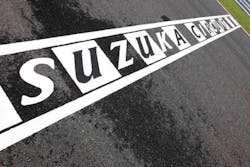Suzuka in Japan has been the scene of many battles for the championship, but this year Sebastian Vettel needs just one point to make sure of his second consecutive title, joining a very exclusive club of drivers to win back-to-back championships: Alberto Ascari (1952-53 – both titles won on Pirelli tires), Juan Manuel Fangio (1954-55 – ’54 title won on Pirelli tires), Jack Brabham (1959-60), Alain Prost (1985-86), Ayrton Senna (1990-91), Michael Schumacher (1994-95 and 2000-2004), Mika Hakkinen (1998-99) and Fernando Alonso (2005-2006).
First though, he needs to get to the end of a demanding 53-lap race in Suzuka, using Pirelli’s P Zero Yellow soft tires and P Zero White medium tires. That is assuming conditions stay dry: Suzuka’s location close to the coast means that there is a high risk of wet weather, which caused qualifying to be postponed until Sunday morning last year. As usual, Pirelli’s P Zero Blue intermediate and P Zero Orange wet tires are ready for use if necessary.
Whatever the weather, Suzuka is one of the most varied races of the year for the tires. Here are a few reasons why:
The track
The S curves at the beginning of the lap consist of a sequence of bends taken at high speed. The tire is subjected to continual sideways accelerations, which challenge the shoulder of the tire and take it to the limit of adhesion. The tire has to give the driver good turn-in, driving precision and lateral grip, while being quick to adapt itself to a slightly different type of asphalt – which is less abrasive but does not offer quite as much grip as other parts of the track.
The Spoon corner has a continual constant radius. At 112 mph the lateral force equates to 2.5G, which is combined with just over 1G of forward force as the car accelerates out of the corner. This places heavy demands on the compound and the structure. In fact, this is typical of the whole circuit, which is very flowing and so has the least traction demand of the year. The only two places where proper traction is needed are out of the hairpin (Turn 11) and the downhill final chicane. Braking effort is also low at Suzuka.
130R is one of the fastest corners. The drivers arrive at it in seventh gear at 193 mph. It’s a long corner with plenty of grip and this allows the drivers to take it flat-out, producing a pressure of 1764 lbs. or more on the front-right tire, which has to keep the car on the correct racing line and deal with a considerable sideways force at the same time.
The final chicane, which is a favored point for overtaking and the scene of the well-known clash between Alain Prost and Ayrton Senna in 1989, is made up of tight right angles, which leads onto the main straight where the cars are at full power once more.
Thinking laterally
With its unique combination of high-speed corners, Suzuka puts the highest lateral loads on tires all year, which is the main feature of the Japanese track from a tire point of view.
A lateral load is a sideways force on the tire, which pushes it to the outside of the corner. At the same time, the tire is still providing grip through friction against the track surface, so a lateral load flexes the structure of the tire and can also increase wear by encouraging sideways movement of the tread pattern on the track.
This flexing and sliding causes heat build-up, particularly in the shoulder of the tire, which is the part that moves around the most. In turn this can lead to blistering, which is where chunks of the tread pattern come away due to localized excess heat. If uncorrected, this eventually causes the surface of the tire to break up and affect performance, which is why tire temperature is such a vital parameter.
On most circuits, the straights provide an opportunity for tires to cool down, due to the lack of sideways forces exerted on them when the car is not cornering. But the first half of the Suzuka lap in particular is just a series of fast bends, with no real straight during which the tires can recover from the demands placed on them.
This is what makes Suzuka especially challenging for the tires. Driver will have to manage their allocation carefully this weekend and keep tire temperatures under control. When working at their hardest, as is the case at Suzuka, the hottest part of the tire tread can reach temperatures of up to 248° Fahrenheit.
Latest in Retail
Latest in Retail



